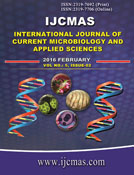


 National Academy of Agricultural Sciences (NAAS)
National Academy of Agricultural Sciences (NAAS)

|
PRINT ISSN : 2319-7692
Online ISSN : 2319-7706 Issues : 12 per year Publisher : Excellent Publishers Email : editorijcmas@gmail.com / submit@ijcmas.com Editor-in-chief: Dr.M.Prakash Index Copernicus ICV 2018: 95.39 NAAS RATING 2020: 5.38 |
Predisposition to urinary tract infections (UTIs) in diabetes mellitus results from several factors. Susceptibility increases with longer duration and greater severity of diabetes. The continuous emergence of resistance to antimicrobial agents among the prevalent pathogens is the most dangerous threat for the treatment of infectious disease in type 2 diabetes mellitus. The production of ß-lactamases is the major mechanism of bacterial resistance to ß-lactam antibiotics which considered the most widely used class of antibiotic. Hence it is necessary to know the prevalence of ESBL so as to formulate a policy of empirical therapy in type 2 diabetes mellitus of the study was to characterization of ESBL genes in E. coli and Klebsiella pneumoniae from urinary tract infection among type 2 diabetic patients. A prospective study was carried out on 1560 diabetic patients with urinary tract infection during the period of July 2011 to June 2015. 277 Gram negative bacterial were isolated and identified by standard laboratory techniques. Antimicrobial sensitivity testing was performed on Mueller-Hinton agar plates with commercially available discs by the Kirby-Bauer disc diffusion method. 90 E.coli isolates and 64 K.pneumoniae were tested for ESBL production and PCR was performed using 5 sets of previous published primers to amplify type-specific ESBL genes, including CTX-M-1, CTX-M-2, CTX-M-9, TEM and SHV 46.7% of E.coli and 59.4% of K.pneumoniae were ESBL producers. Of the 42 ESBL-producing E. coli isolates, 38 (90.5%) were positive for ESBL genes and 47.4 % of the E.coli isolates had at least 2 ESBL genes. and CTX-M-9 was seen in 7 (18.4%) isolates. Among K. pneumoniae, 32 (84.2%) of the 38 isolates were positive for ESBL genes and The number of ESBL- producing K. pneumoniae with TEM was in 6 (15.8%) isolates. This study highlights the high prevalence of ESBL production among E. coli and K. pneumoniae in the urinary tract infection among type 2 diabetic patients. Therefore, genotyping of ESBL is need of the hour for monitoring the significant ESBLs that can lead to treatment catastrophe in diabetic patients.
 |
 |
 |
 |
 |